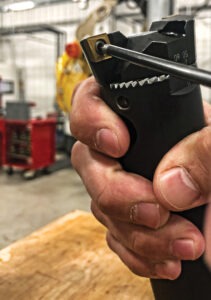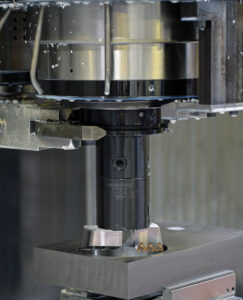How to Enlarge Existing Holes When Machining Metals
Boring bars, end mills, reamers, indexable drills — there are a myriad of tooling options when opening or enlarging existing holes, but which should you choose for your application? When opening an existing hole, you are often faced with three…
Posted: August 22, 2024

Boring bars, end mills, reamers, indexable drills — there are a myriad of tooling options when opening or enlarging existing holes, but which should you choose for your application?
When opening an existing hole, you are often faced with three different categories — making a correction, holding a specific tolerance or surface finish, or removing excessive material. When making a correction, the stock removal is likely less than 0.005 inches, and focus should be placed on the sharpness of the cutting edge on a reamer, boring tool or end mill. If you are looking to hold a specific tolerance or surface finish, you should ream or bore because you are being intentional with the size of the hole. Lastly, if there is more than the desired amount of stock to remove or the material removal is more than a typical reamer would handle, indexable drills or rough boring tools are the cutting tool solution that will be best. Nevertheless, like most applications, it is key to gather all application details — machine type, material, any unusual conditions, interruptions, etc. — when selecting the best cutting tool solution for enlarging existing holes.
If you are making a correction or time is not critical, milling is a fine option; furthermore, if there is a shallow length of cut with a reasonable surface finish requirement, you can come in with a mill and get a little bit of that material out. However, removing a lot of material using an end mill is costly and time consuming; coring or rough boring will always be the fastest at removing material from the cut when enlarging a hole. In a similar vein, indexable drills will typically finish the operation in one pass; whereas, a mill requires multiple passes. Cycle times that take one to two hours per hole with a mill can potentially be completed in a matter of minutes with an indexable drill. Ultimately, the more metal to remove the more attractive indexable drills become. Plus, utilizing your machine’s power rather than speed will help in roughing out holes faster than a mill.
What about helical interpolation? Using an end mill to helically interpolate when removing smaller amounts of material may create a round hole, but it will most likely be tapered. While this can be minimized by reducing the feed, it can give you limitations on surface finish and repeatability on size and shape due to deflection and tool wear. Using a boring head, twin cutter rough boring tool or an indexable drill will allow you to create a round hole while the improved repeatability will reduce downtime; no more measuring and compensating your end mill. Still though, you could argue that interpolating with a mill is more effective at achieving good chip evacuation in deeper hole-opening applications. If chips are not small enough or coolant delivery is not sufficient, then you could risk tool failure with an indexable drill, but once the correct insert grades are selected and other parameters are set for that drill or twin cutter, chip evacuation should not be an issue even in challenging materials like stainless steel and high-temp alloys.

Enlarging an existing hole could also be done with a reamer or boring head if there are critical surface finish requirements and tight tolerances are needed; simply stated, you must be intentional with the size of the hole. When choosing to use a reamer, you are likely to have a very small amount of material to remove, need a certain surface finish tolerance, and have a lot of parts to run with a good tolerance on diameter to repeatedly get to. Boring, on the other hand, would be good for hole opening applications if the job is not as high volume. With a reamer, you can move faster through the metal and get an even better surface finish than a boring head. While there can be some overlap between these two cutting tools, tooling selection comes down to what you are looking for in terms of cycle time reduction or what surface finish and hole tolerance needs to be hit — the more technical specifications of what is needed. All in all, it depends on the needs of the application, but reamers and boring heads are simply utilized more when hole tolerance and surface finish are most important.
If there is excessive material to remove, it is likely that you will be looking at indexable drills, large end mills or rough boring tools as the tool of choice for the application. While you need to identify the scope and goal of what you are trying to accomplish, it is important to keep in mind any application factors as well. Are you aiming to keep a tight tolerance or are you trying to reduce cycle time? What tool is going to be the most effective and user-friendly for machine operators? Examining an application through this lens will aid in deciding which tool is best.
Large mills require a lot of inserts as well, but milling inserts allow for higher feed rates. However, indexing 15-to-20 inserts on a mill can be a major contributing factor to longer cycle times — not to mention the cost of the number of inserts that must be kept on hand. Conversely, an indexable drill may only require six-to-eight inserts and a rough boring tool would require two to eight; both of which would take less time to change and allow you to get back to making chips more quickly, so the quantity of inserts can be prohibitive in some situations.

What about solid carbide end mills? These are not the best option when removing excessive material because they simply cannot take much material; additionally, the depth of cut is minimal, there is tool wear and deflection, and the hole will most likely be tapered. Solid carbide end mills and milling cutters are both limited on length of cut as well.
Ultimately, indexable drills and rough boring tools are often the preferred tools when enlarging existing holes that have excessive stock removal. The need to remove excessive material often stems from a part being previously in process or involves castings, which are rarely precise and, therefore, have more material to remove. Not only do these cutting tools significantly improve cycle time, but they also require minimal inserts and have a deep length of cut. However, obtaining good chip form can be a challenge. While end mills will always make better chips, a variety of geometries of inserts for indexable drills and rough boring tools in addition to adjusting speeds and feeds will aid in improving chip formation. All in all, when removing excessive material, it comes down to machine time and better throughput in production.
Move Beyond End Mills
To move away from end mills when opening existing holes, companies such as Allied Machine & Engineering offer a variety of cutting tool solutions that can improve your applications including products such as the Opening Drill and Revolution Drill from Allied Machine & Engineering, and Wohlhaupter’s VolCut and other rough boring twin cutters.
The Opening Drill’s name speaks for itself; this drill is best when you have an existing hole that you are taking out to size and is ideal for fairly shallow depths. With an Opening Drill, you are confident that you are running a roughing application. The hole will be as precise as you are able to set up on your presetter. Ultimately, you might not have the horsepower on the machine to run from solid, so you have to step drill a bit and then open the hole out to a larger diameter. Lastly, the Opening Drill has flutes that allow it to perform better in vertical applications with poor coolant pressure and volume. So, the sweet spot for the opening drill would be shallow, large diameter holes on lighter duty machines.
Similarly, the Revolution Drill is an effective tool that drills large diameter holes from solid with or without an existing hole, or it can open existing holes as well. It is ideal for lighter duty machines while also maintaining high penetration rates. This drill might be a good option too when you want to follow with the Opening Drill; if you don’t have the horsepower or torque on the spindle to open a 4” hole from solid for example, you can start with the Revolution Drill to conserve horsepower and torque and then come in with the Opening Drill to reach your final diameter.
For diameters larger than what the above drills can be used for, Wohlhaupter’s VolCut twin cutters are also capable of taking an existing hole to size. If you are currently taking a lot of bulk passes with a rough boring tool, this twin cutter will decrease your cycle time by cutting out multiple passes and maintain precision. Ultimately, the twin cutter is great for roughing out existing holes on machines with various shank requirements in addition to having the capability to go a little bit longer because of its modular design.
Other Wohlhaupter rough boring tools, for example, are also effective when enlarging existing holes. Twin cutters, which only require two inserts, are available in both same-level and height-displaced cutting. Same-level twin cutters utilize double effective cutting, providing reduced cycle times with increased penetration rates. Conversely, height-displaced twin cutters provide the ability to offset the insert holders, resulting in more material removal and less machine load requirements. Other benefits of these rough boring tools in hole-opening applications are the inserts and the modular components. Not only are there many options for insert geometries and grade selections, but modular boring components allow for a variety of length options and machine adaptability — providing versatility to your hole-opening applications.
With tools like these, the time saved throughout a hole-opening application, while also reducing downtime and establishing a more repeatable hole, is clear. They provide a complete solution for large diameter applications.



















